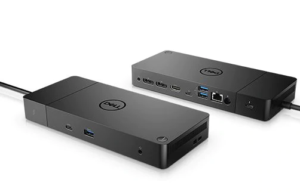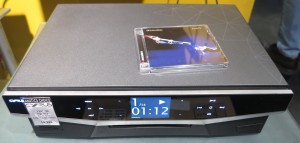Dell designs their business USB-C docks for the long haul
Article – From the horse’s mouth
Dell
WD-19TB Thunderbolt 3 dock (Product Page)
My Comments
Dell has defined a series of business USB-C docks that can have their host connectivity technology upgraded or replaced by the user.
What are these docks about?
This series of expansion modules, known as the Dell WD19 family have in common video connections in the form of a single HDMI, two DisplayPorts and a USB-C with DisplayPort alt mode connectivity. The above-mentioned USB-C DisplayPort-enabled port, along with another USB-C port located up front offer data transfer and Power Delivery power-source functionality. There are three USB 3.1 Type-A sockets with one up-front along with a Gigabit Ethernet network-adaptor function. As well, there is a basic USB sound module that has a headphone/microphone socket up front and a line-out socket behind, which may suit the use of a wired headset, powered speakers or that old stereo amplifier connected to those old speakers you use for computer sound.
The devices are pitched for business use, especially with large businesses who practice hot-desking a lot, using shared workspace setups where you connect a laptop computer to at least one large screen as well as a full-size keyboard, full-size mouse and Ethernet network connection. This leads to separate modules being available for USB-C connectivity, Thunderbolt 3 connectivity and dual-USB-C connectivity depending on the performance needs of the workspace’s user group.
The power available on these units is up to 90 watts for equipment adhering to the current USB Power Delivery specification. But Dell takes this further to 130W for their own products because this specification currently doesn’t address the likes of the XPS 17 which demand more power output. This may be something that will be investigated by the USB Implementers Forum for supporting USB Power Delivery on higher-powered devices namely powerful large-screen laptops or “next-unit-of-computing” desktops.
For that matter, the Thunderbolt 3 variant has another USB-C port that supports Power Delivery, USB-C and Thunderbolt 3 data transfer and DisplayPort alt mode.
If you are buying the docks, you can choose between the different units offering the different host connectivity types and pay appropriately for the connection type. But Dell sells these modules as a separate accessory so you can upgrade your dock to a better host-connectivity type like Thunderbolt 3.
What I like about this family of docks and the user-replaceable host-connectivity modules that Dell offers is if a host-connectivity module fails and the dock becomes useless, you can just replace that module. There is also the ability to upgrade your dock to newer expectations at a later time.
Although this is optimised to work primarily with Dell computers, the WD19 series of docks can work with any computer that has a USB-C or Thunderbolt 3 connection. This is in a totally “plug-and-play” manner without the need to install device drivers.
Room to innovate
But it could allow Dell to have a range of business-class docks ready for full-on USB4, Thunderbolt 4 or any future host-peripheral connection technology. This is with the ability for users to upgrade them to that technology when the time comes.
Also having user-replaceable host-connectivity modules could open up to Dell the idea of external graphics modules with soldered-in graphics chipsets that can be added on to these docks. Most likely this idea would be limited to high-end mobile graphics chipsets that give a bit of “pep” to your Ultrabook’s graphics rather than desktop graphics chipsets that provide the full performance.
As well, having the dock part as a separate module can allow Dell to build on this system further. For example, it could also be about creation of a multimedia variant of this dock with a better sound module having line inputs or SPDIF connectivity along with more USB connections. Similarly, there could be a dock with multiple-Gigabit Ethernet connectivity that could appeal to “workstation-class” network computing.
Limitations that are identified
From all of the material I have seen on the Internet about these devices. there are some limitations that show up here.
For example, for the single-USB-C or Thunderbolt-3 connection modules, Dell could fit each module with a USB-C socket for the upstream (host-side) connection rather than using a captive USB-C cable. This could allow the user to use longer USB-C cables thus allowing for installation flexibility. It can also allow the user to replace a broken cable themselves, something that will become real if they frequently plug and unplug their laptop from the dock.
From a video review that I had seen, there could be the ability to support Thunderbolt-level multiple-screen display for three outputs for the Thunderbolt 3 variant. This could work better with the Apple Macintosh platform, but “open-platform” implementations like Windows don’t need to worry about this issue much. But it may not work properly with the modular approach behind this dock’s design.
Conclusion
But the Dell WD19 business USB-C dock family underscores the reality that you have to pay dearly for something that is robust and will last you in to the long term. It can also show that a design platform can be achieved for premium, business and multimedia docks where there is a goal to see them last longer and be future-proof.



